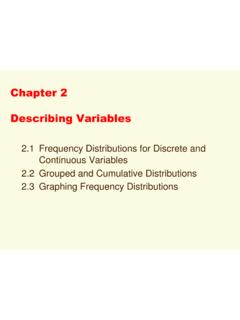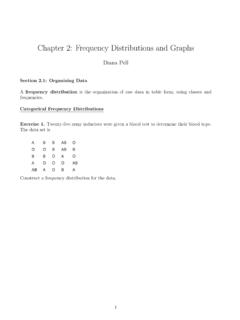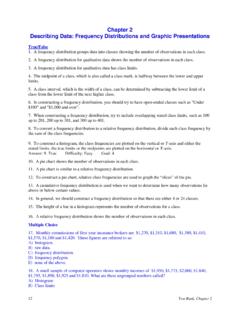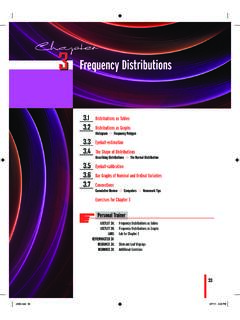Transcription of Chapter 2: Frequency Distributions and Graphs Section 2 ...
1 Chapter 2: Frequency Distributions and Graphs Section 2: Histograms Worksheet 1. The data shown are the number of grams per serving of 16 selected brands of cakes. Construct a grouped Frequency distribution using 5 classes. Construct a histogram. 32 47 51 41 46 30 46 38 52 48 48 38 43 41 21 24 See Chapter 2 Section 1 Worksheet, #3 for solution to grouped Frequency distribution . 0 1 2 3 4 5 6 To To To To To Number of Cakes Grams Per Serving Grams Per Serving for Selected Cake Histogram: Notice that the x-axis uses the class boundaries. Histograms share borders (they touch), so we must use class boundaries. The only time there is a gap in the histogram is when there is a Frequency of 0. Always have a title for the Always label and title your x- axis. Always label and title your y-axis.
2 The height of the column represents the Frequency for the class. Reading the histogram, we can see that the first column has a height of 2. This means that 2 cakes are to grams per serving. We can see that the highest Frequency of cakes is 6 with to grams per serving. 2. The following figures give the telephone bills (in dollars) of twenty residents of Metroville. Construct a grouped Frequency distribution with 5 classes. Construct a histogram. 0. 1. 2. 3. 4. 5. 6. 7. To To To To To Number of Residents Telephone Bill (in Dollars) Telephone Bill for Metroville Residents Telephone Bill for Metroville Residents (This is the class using limits ) Telephone Bill (In Dollars) (This is the class using boundaries) Telephone Bill (in Dollars) (This is the Frequency ) Number of Residents 7 6 3 2 2 Range = highest value lowest value.
3 = . Always round up to the next # with the same # of place values as the data. Since the data have two decimal place values (in thousandths), we round up the class width to the next # in the thousandths. So is now our class width. Notice that the only separation between the classes with limits is one thousandths ( ) since the data values have at most two decimal place value (thousandths). The lower class limit for the 1st class will be smallest data value ( ). To get the lower limit for the next class, we add the class width ( ) to the lower class limit of the 1st class. We repeat this until we have the lower limits for the 5 classes. To get the upper class limit of the 1st class, we subtract one thousandths ( ) from the lower limit of the 2nd class since the data have at most two decimal place values (thousandths).
4 To get the upper limit for the next class, we add the class width to the upper limit of the 1st class. We repeat this until we have the upper limits for the 5 classes. Always have a title for the Always label and title your x- axis. Always label and title your y-axis. 3. The following are the hourly wages (in dollars) of thirty factory workers. Construct a grouped Frequency distribution with 6 classes. Construct a histogram. Wages for Factory Workers (This is the class using limits ) Hourly (In Dollars) (This is the class using boundaries) Hourly Wages (in Dollars) (This is the Frequency ) Number of Workers 6 9325 8 6 4 5 1 Range = highest value lowest value. =.
5 0. 1. 2. 3. 4. 5. 6. 7. 8. To To To To To To Number of Workers Wages (in Dollars) Hourly Wages for Factory Workers 4. The following are cholesterol readings (mg/deciliter of blood) of twenty patients. Construct a grouped Frequency distribution with 7 classes. Construct a histogram 184 230 195 186 240 190 238 254 225 237 210 224 214 197 203 233 198 215 216 205 0 1 2 3 4 5 To To To To To To To Number of Patients mg/deciliter of blood Cholesterol Readings Wages for Factory Workers (This is the class using limits ) Hourly (In Dollars) (This is the class using boundaries) Hourly Wages (in Dollars) (This is the Frequency ) Number of Workers 184 194 183. 5 3 195 205 5 206 216 4 217 227 2 228 -238 4 239 249 1 250 - 260 1 Range = highest value lowest value.
6 254 184 = 70 707=10 5. A study was conducted on the amount (in dollars) spent on gas for 30 random people. Construct a grouped Frequency distribution with 5 classes. Construct a histogram. 44 50 45 42 46 34 44 34 39 41 43 37 47 37 36 45 47 34 39 37 30 40 41 45 45 36 31 39 35 43 0. 2. 4. 6. 8. To To To To To Number of People Amount Spent (In Dollars) Gas Spending See Chapter 2 Section 1 Worksheet, #7 for solution to grouped Frequency distribution . 6. The highway police department conducted a survey and clocked the speeds of 100 cars. Construct a histogram. Construct a histogram using relative Frequency . What portion of cars were clocked at less than 60 miles per hour? Speed (in mph) # of Cars 48 50 30 51 53 15 54 56 5 57 59 20 60 62 15 63 65 15 0 5 10 15 20 25 30 35 - - - - - - Number of Cars Speed (in miles per hour) Clocked Speeds 7.
7 Solandine glycosides are natural constituents of potatoes and in high amounts can cause toxicity. Fifty fresh potato tubers were analyzed and the amount of solandine (mg/kg) determined. Construct a histogram. Construct a histogram using relative Frequency . (mg/kg) Frequency 20 29 10 30 39 0 40 49 18 50 59 12 60 69 8 70 79 0 80 89 2 0 2 4 6 8 10 12 14 16 18 20 - - - - - - - Number of Potato Tubers Amount of Solandine Glycosides (in mg/kg) Solandine Glycosides in Potato Tubers









